Strong multiplayer maps in video games create stories. Their construction and design generate emotional reactions from frustrated defeat to jubilant victory. It is not enough to put players in a space and do battle; strong maps shift and contort in unexpected ways. They are not always fair and they are rarely symmetrical, but they will create tons of drama.
One map in the popular online shooter Overwatch has a reputation for being unfair. It’s called Eichenwalde and is not a playing field for 50/50 play. If you play on the attacking team, you’re at a disadvantage. If you’re defending, you’re likely to win. Attackers seek difficult but rewarding victory while defenders revel in their slaughter.
“The initial idea was to move a payload up to a castle on a hill,” the game’s principal level designer, Dave Adams, told me when we recently discussed the map. “On the gameplay side, we wanted to experiment a bit more with verticality and open areas.” In Eichenwalde, a massive castle towers above the war-torn ruins of a once idyllic village. The attacking team presses forward to their objective through tight choke points and uphill climbs while determined defenders snipe from high ground and block the path with shields.
Capturing flags is fun but capturing a fortress is exhausting work. Conquest evokes images in our minds: tiresome marches, bold counter offensives, desperate last stands, and spite-filled duels. It also suggests a landscape: uphill. Traversing flat spaces in games is a dull affair. You press forward and go. Climbing is dynamic. Ascent feels difficult, and high locations command authority. Descent is both dangerous and exciting. We enter spaces unknown with nothing but our grit and skill to save us. Eichenwalde has all of these things.
Eichenwalde has three parts, each an antepiece for the next. A grind towards the first capture point teaches players on both sides about tight spaces. The push leading to the castle gate prepares teams for extended battles around the payload. The final segment combines these two things into a cohesive and challenging whole. In most of these encounters, the defending team has the advantage of high ground, and the attackers must drive them back from these key locations.
The challenge is understandable but slightly unfair, and that creates Eichenwalde’s stories. Play the map and you may have your entire team knocked off a bridge or wiped by an ultimate ability in a tight space.
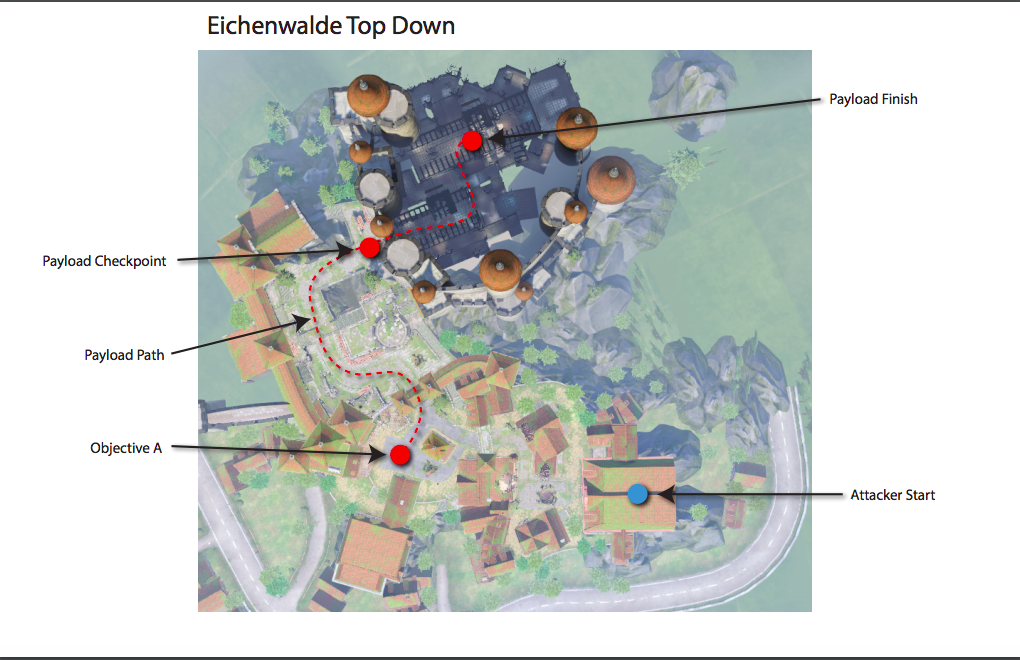
Overhead map provided by Blizzard
If you’ve played Eichenwalde even once, you’ll experience how difficult the attacking push is. The map had been in the game since last September and has developed a reputation for being tough for the attackers. That focus on hard-won gains makes it one of the most exciting maps in the entire game.
“We don’t go into making any map with a plan for it to be easier or more difficult than other ones,” Adams said. “There was no intention to make Eichenwalde a very defensible map throughout, but that did happen. We strive to make each map a fifty-fifty win rate, or as close to it as we can. Eichenwalde has been a bit of an outlier in that respect.”
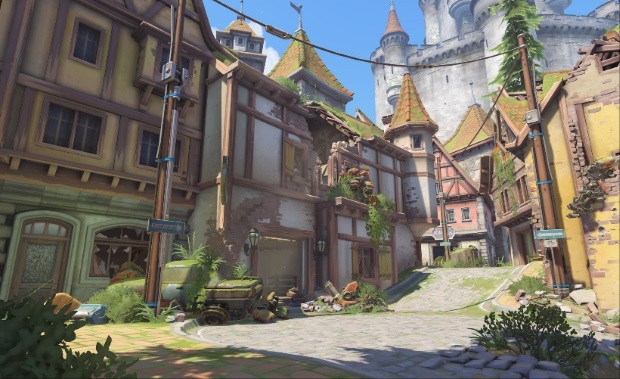
There are three paths coming out of spawn. All are dangerous.
Eichenwalde establishes itself as a difficult map from the start. Moving up from the attacking team’s spawn, there are technically three ways to proceed: a direct path through the village streets, a brief shortcut through a ruined cottage, or a winding side path to the far left that comes around to the control point. The latter two are impractical for a full team push but do provide health packs for flanking characters like Tracer and Sombra to make use of. That leaves the main pathway, notoriously difficult due to a small bridge that crosses over the road.
Eichenwalde is defined by this choke point, which affords the defending team a lot of ways to repel the players on the attack. High ground is a coveted commodity in Overwatch and is crucial in this map. Sustained damage dealers like Soldier: 76 and Bastion thrive in these positions, and this bridge provides ample coverage of the main road. The tight passage under the bridge benefits defensive heroes like Symmetra, who can place turrets in this area to shut down anyone who rushes underneath.
The burden on the attacking team is massive, but Eichenwalde finds an identity in this space. Attackers might double down on beefy tank characters or extra healers to charge through. Alternatively, they might choose characters like the jetpack-wearing Pharah or leaping ape Winston, who can leap over much of this area. Action expands and contracts around these areas, creating a pace unique to the map. It is less about extended gun-fights and more about short, explosive charges further into the map.
The focus on expanding and contracting the action comes to a head on the first control point, where the attackers must congregate in order to seize a battering ram to push up to the castle gates. Emerging from the claustrophobic streets, this area opens into a large plaza. While houses towards the back of the point provide additional space for flanking characters and some high ground for damage dealers, the majority of terrain around the first control point is flat ground with a few piles of debris. There is one huge exclamation point: a large spire that splits sight lines.
The broken field of view creates a problem for the defending team as they return to battle. The battle at this part of the map involves the attackers trying to claim the control point. They’re not advancing now but trying to hold the space for 30 seconds. Attackers can die and easily rush up the main road, but when a defender dies and respawns, the spire limits their view heading into the action.
As a consequence, the attacking team can dig in at the capture point and are free to quickly return from their own spawn point when they resurrect as long as a teammate is holding the point. Defenders either need to split up to block this pressure or commit to a full team fight. Eichenwalde has a reputation for favouring defence, but the initial control point reverses that dynamic as it alters the number of vertical options. Here, at least, the attackers have the advantage.
Eichenwalde explodes upward after the first point is captured. Attackers must climb a steeper incline than what led to the capture point. As they draw closer to Eichenwalde Castle, higher bridges and parapets provide extremely vertical options for defenders to hold or attackers to claim. This section fleshes out the map’s distinct personality. One of the flattest levels in Overwatch is King’s Row, featuring an extended escort segment across level ground that eventually dips lower upon entrance to an industrial area. The middle segment is an unremarkable battlefield that creates dull stories as a result. Eichenwalde oscillates between raised terrain and level spaces in order to modulate difficulty from moment to moment.
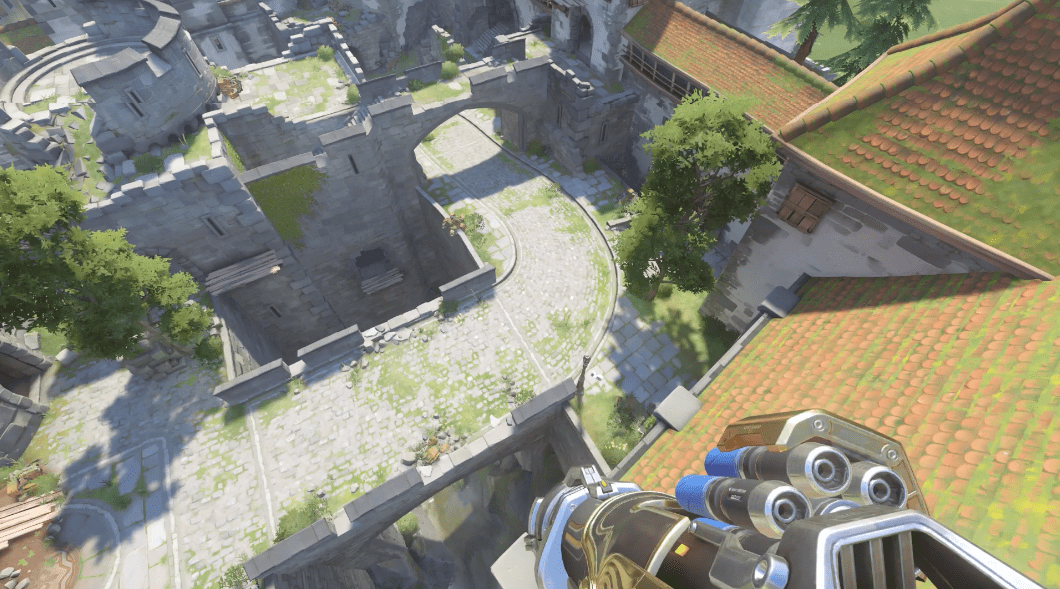
Eichenwalde’s second area has numerous high vantage points.
Eichenwalde’s escort segment takes the map’s initial scenario and increases the scale. There is more space for defenders to move under the first bridge, but aggressive pushers must now consider the expanded high ground to the side. These locations provide opportunities for defence characters to shine. The highest tower is a favoured spot for the bomb-lobbing Junkrat or eagle-eyed hitscan characters like the sniper Widowmaker or gunslinger McCree. An underlying tangle of rooms offers options for flanking characters to ambush defenders, but the attackers’ path eventually converges on an open bridge right before the checkpoint at the castle. It’s another difficult position for the attackers to rest in and often requires shifts to a shield-wielding tank like Reinhardt or Orisa to dig in as the defending team fires in from the castle entrance.
The discrete chunks of Eichenwalde often call for a change in team composition on both sides. Turrets created by builder characters like Torbjörn do well in the lead-up to the capture point but suffer in the open space leading to the castle. Defenders might find themselves opting for characters who deal more direct damage while the attackers shift to tanks and aggressive “dive” characters like Winston or D.va to counter.
The notion of shifting terrain and alternating power dynamics appears to be present even in test builds of Eichenwalde. In the early development footage above, members of the Overwatch team including lead designer Jeff Kaplan play through an early version of the map. The first two sections are largely unchanged although the space is slightly more constricted. It is easy to see the way Eichenwalde moves teams through funnels before allowing them to emerge into wider space.
Eichenwalde doesn’t hold on to the extreme verticality of the first escort segment for very long. Nor does it hold on to the bright and colourful art design that characterises the outlying village. Befitting the mood of a final frantic push towards victory, the last segment of map takes place within the dark confines of Eichenwalde Castle. It tosses the battle into an extended sequence of close quarters combat in a dark, gloomy space.
Ceilings are lower, side paths more winding, and the defending team’s spawn point deposits them almost directly onto the final capture point. Eichenwalde becomes more hostile in visual tone and construction. For some heroes, this provides challenge, while for others it is a new opportunity.
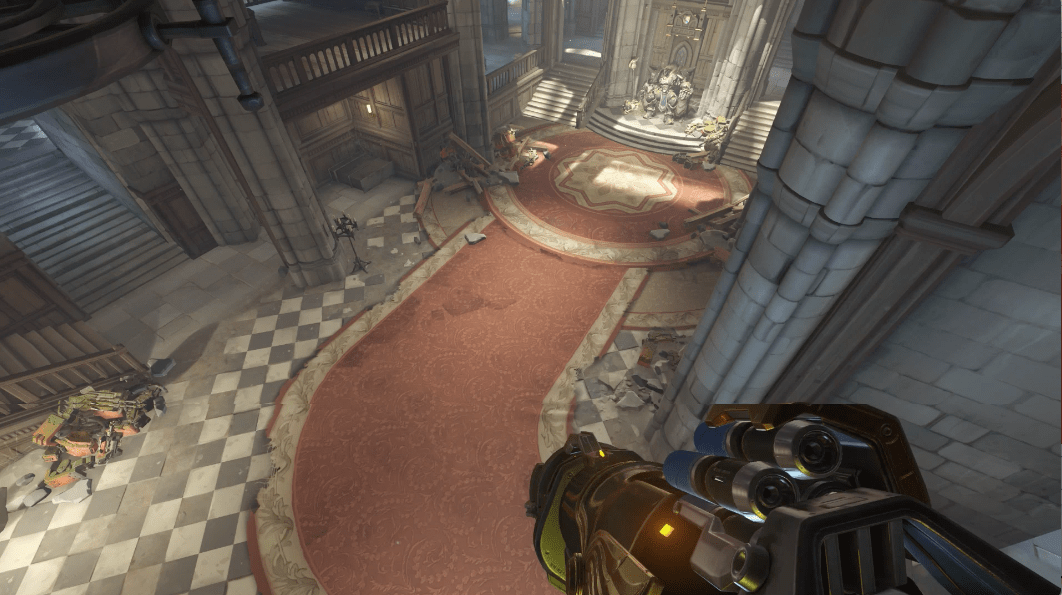
The final segment is much more constrained than what came before.
“Some characters can benefit from those differences, while it may become a bit more difficult for others,” Adams said. “Pharah has her way with two thirds of the map, and while the interior is more restricted for her and some others, they are still viable heroes in the castle. The key for any team is to adapt to the changing situation in the different gameplay spaces and try a different strategy.”
Across its major phases Eichenwalde proves to be a rigorous test in adaptation. All maps in Overwatch demand a degree of reactivity based upon topology and team compositions, but Eichenwalde seems particularly keen on challenging players with new complications in each segment.
Eichenwalde crafts a story much more easily than other Overwatch maps. Its highs and lows are etched right into the landscape. Some maps, like Hollywood, are breezy affairs, but Eichenwalde demands players rise to the occasion. It creates heroes who lead the charge and villains who laugh from high towers. It tells a terrific tale.
This story originally appeared in July 2017 and has been republished to help highlight the wonderful contributions women have made to Kotaku Australia over the years, our way of acknowledging International Women’s Day.
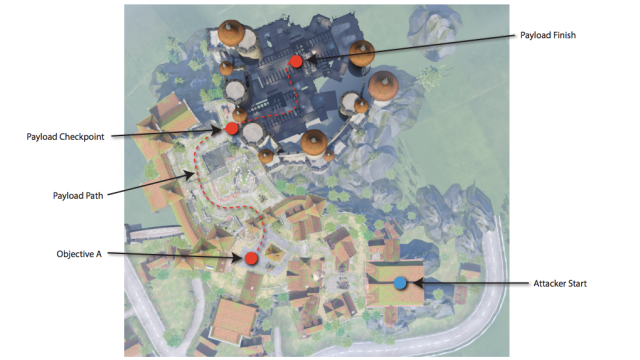
Comments
One response to “An In-Depth Look At Overwatch’s Eichenwalde Map”
Awesome Article thanks for the insight 🙂 i love reading about others perspectives on maps in Overwatch.
I used to hate this map when it first came out but now its always one of my favourites when it comes up in the rotation!